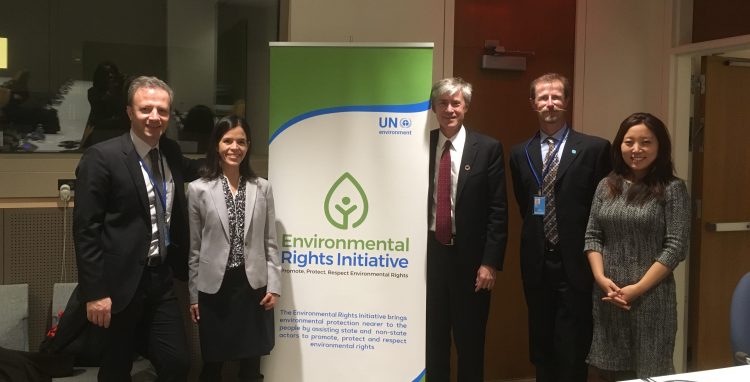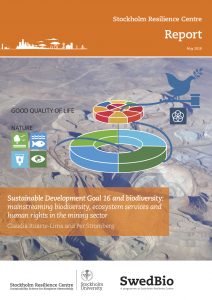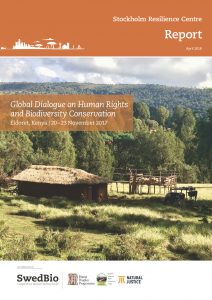 Story highlights
Story highlights
- If the UN General Assembly recognized the right to a healthy environment, it could accelerate the transition towards a renewable energy future, the access to safe drinking water and adequate sanitation for millions and, to protect the diversity of our planet and safeguard life.
- Recognition of the right to a healthy environment by the UN would be a meaningful way to empower and protect the courageous people who fight for biodiversity.
- New Peer-to-peer dialogue report contributes to the conceptualization and design of draft elements to incorporate SDG16 and principles of human rights and good governance into the post-2020 global biodiversity governance framework in a new dedicated target and as crosscutting dimensions of all targets of this framework.
History matters
2018 marks a milestone in the history of human rights. Seventy years ago, in December 1948, the United Nations General Assembly proclaimed the Universal Declaration of Human Rights which set out the fundamental rights of all peoples, of all nations. Representatives from all over the world, with diverse backgrounds and expertise spanning from the law to culture drafted the declaration which has since been translated into five hundred languages. Preceded by two world wars, the document stands out as a record of countries coming together after brutal conflict to recognise the inherent dignity of all human beings and the rights of every single person to freedom, peace and justice.
Human rights depend on a healthy environment
However, while human rights principles lie at the heart of international agreements and form the pillars of international development cooperation for many countries, the human right to a clean and healthy environment is increasingly under threat in many parts of the world. The causes include large scale, global loss of biodiversity and natural resource extraction that degrades the ecosystems on which communities rely. The stakes are particularly high for environmental rights defenders who risk their life to safeguard biodiversity and healthy ecosystems. In 2017, Global Witness documented 197 deaths, almost 4 every week, of environmental defenders, as a direct consequence of their actions to stand up to governments and companies damaging the environment.
A sense of urgency
With two years left before the UN Biodiversity Conference in 2020, The Secretariat of the Convention on Biological Diversity has stated that unless additional actions are taken, the status of biodiversity is likely to decline further and the Aichi Biodiversity Targets will not be met. At the same time, there is an increased recognition at the international level that business as usual is no longer an option.
One of the agenda items at this month’s UN Biodiversity Conference in Egypt, is a comprehensive and participatory process for the preparation of the post 2020 global biodiversity framework. So far, many states have not met the standards that they themselves set for protecting biodiversity. The more the detrimental consequences of failing ecosystems becomes clear to governments all over the world, the greater are the opportunities to implement fundamental changes. What are the tools that states can use to take effective and immediate action to address the overwhelming challenges? We don’t have to look very far for guidance on how to do this.
Human rights, like the impacts of climate change, are beyond borders. Human rights and ecosystems cannot be separated or isolated from each other or from the impacts of climate change. Ecosystems can help to combat climate change – both through carbon sequestration in natural forests and through their contribution to resilient ecosystems and societies. Conversely, without healthy ecosystems, the impacts of climate change adversely affect human rights, by reducing resilience of communities, which has the effect of increasing vulnerability to social, economic, political and environmental shocks.
Luckily, we have only to go and look at the principles set out seventy years ago in the Universal Declaration of Human Rights – those principles that have been at the core of international law governing the human right to a healthy and sustainable life in the past to see that they provide a clear map for the present and the future. This is because human rights principles mirror the key elements for a global biodiversity framework that holds states to account. Specifically, Participation and Inclusion and the Principle of Accountability and Rule of Law. Since transparency is a key dimension of this latter principle, it could add a valuable component to formulating a post 2020 global biodiversity framework that states can actually stick to.
Advancing SDG 16 as a cross cutting issue for peace and a healthy planet for all
Like sustainability, human rights are a crosscutting dimension of Agenda 2030 and, more specifically, are recognized in Sustainable Development Goal 16 (SDG 16) which aims to “Promote peaceful and inclusive societies for sustainable development, provide access to justice for all and build effective, accountable and inclusive institutions at all levels.”
Parties to the Convention on Biological Diversity and other relevant groups are currently discussing the process to develop the post 2020 global biodiversity framework. Several organizations, including SwedBio and its partners, have been pooling knowledge and expertise to help shape the future content of the post-2020 global biodiversity framework.
Human rights are integral to each and every SDG
In May 2018, SwedBio, the International Development Law Organization, UN Human Rights Special Procedures and UN Environment, Natural Justice convened a Peer-to-peer dialogue to advance efforts to strengthen the linkages between human rights, good governance and biodiversity. The peer-to-peer dialogue brought together legal practitioners, rights-holders, human rights and biodiversity experts, and environmental human rights defenders, among others, drawn from developing countries and partner organizations. Their goal was to seize the opportunity to shape the post 2020 agenda with several concrete contributions such as proposals to include the nexus between human rights, biodiversity and good governance in the post-2020 global biodiversity framework. The exchanges of knowledge, experience and case studies from the dialogue resulted in a policy report on how on how to weave human rights, SDGs and biodiversity and legal tools that can contribute to implement the human rights to a safe, clean, healthy and sustainable environment. A bold proposal emerged from the dialogue and the report that puts forward the conceptual basis for incorporating human rights and SDG 16 into the post-2020 global biodiversity framework, both as a new target, and as a crosscutting dimension of all targets.
“Human rights is an issue that goes beyond a concern of governments and human rights organisations, to a concern that crisscrosses thematic and geographical areas of work of a wide range of institutions. For this reason, SwedBio and partners wanted to bring together a diverse group of colleagues from different parts of the world and with a wide scope of experiences, to share and exchange practical lessons learned. Together, we aim to build on the existing CBD Strategic Plan and envision the just and safe future that we all want.” Claudia Ituarte Lima, Center researcher and International Environmental Law Advisor at SwedBio
Towards the Global Recognition of the Right to a Healthy Environment
There is momentum and in the past two years there have been landmark affirmations of the indivisibility of sustainable development obligations to observe ecosystem limits and uphold human rights:
The 2016 Cancun Declaration on Mainstreaming the Conservation and Sustainable Use of Biodiversity was followed in March 2017 by a report from the UN Special Rapporteur on Human Rights and the Environment, Professor John Knox. The report made two key points. Firstly, that the degradation and loss of biodiversity undermines the ability of human beings to enjoy their human rights. This does not require that ecosystems remain untouched by human hands – people depend on the use of ecosystems for their social development. However, in order to support the continued enjoyment of human rights, this development cannot overexploit ecosystems – it must be sustainable, and sustainable development requires healthy ecosystems.
On the back of Professor Knox’s report, in March 2017, The UN Human Rights Council adopted a resolution encouraging states to take up an effective normative framework for the enjoyment of a safe, clean, healthy and sustainable environment, including biodiversity and ecosystems.
“It is impossible to resist an idea whose time has come” – Victor Hugo
In October 2018 the UN Special Rapporteur on human rights and the environment, Dr. David R. Boyd urged the UN General Assembly to recognise the right to a healthy environment. Dr. Boyd was tasked by the UN Human Rights Council to report to the highest body in the United Nations system, The General Assembly. The meeting followed expert consultations convened by Prof Boyd with SwedBio, UN Environment and Terres des Hommes and experts from different parts of the world to discuss the challenges and opportunities for advancing human rights and the environment nexus.

Boyd began his speech by summarising the work and finding of his predecessor Prof John Knox. After 6 years as the Special Rapporteur, Prof Knox concluded that there is a gaping hole in the UN human rights systems because the UN has not yet globally recognised the right to a healthy and sustainable environment. Even though the UN has not recognised this right, over 150 Member States have recognised the right to a healthy environment, either through their constitution, national environmental legislation or regional treaties. There are many benefits to legal recognition of this right. These include stronger environmental laws and policies, implementation and enforcement of a level playing field with other social and economic rights and greater public participation in environmental decision-making. Boyd stated that the ultimate test was to see if the right to a healthy and sustainable environment contributes to healthier people and ecosystems. There are positive indicators which show that the recognition of this right at the national level has enabled people to breathe cleaner air, drink cleaner water and reduce their exposure to toxic substances. Recognition of the right to a healthy and sustainable environment has the most impact on vulnerable groups like women, children, the elderly, indigenous people, persons with disabilities and persons living in poverty. In 2008, the Supreme Court of Argentina upheld the right to a healthy environment and improved the lives of people living in the poorest areas of Bueno Aires.
Recognition of the right to a healthy environment by the UN would be a meaningful way to empower, protect, energise and inspire the courageous people who fight for biodiversity, healthy ecosystems and human rights, often risking their lives in the process. Likewise, it would serve as a catalyst to accelerate the transition towards a renewable energy future, to accelerate the access to safe drinking water and adequate sanitation for million and, to protect the diversity of our planet and safeguard life.

 SDG 16 and biodiversity: mainstreaming biodiversity and human rights in the mining sector
SDG 16 and biodiversity: mainstreaming biodiversity and human rights in the mining sector REPORT: Global Dialogue on Human Rights and Biodiversity Conservation
REPORT: Global Dialogue on Human Rights and Biodiversity Conservation Private: Claudia Ituarte Lima
Private: Claudia Ituarte Lima